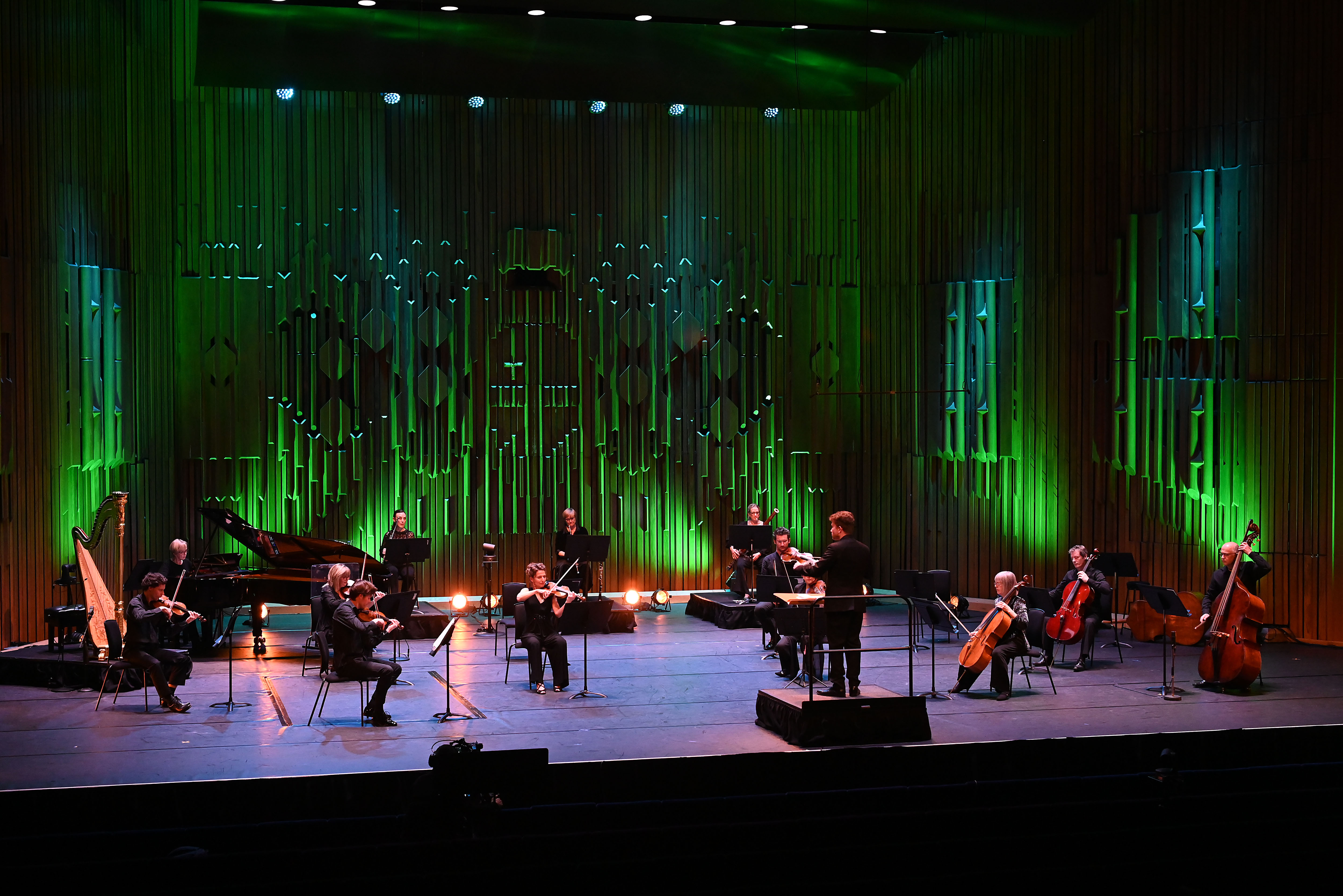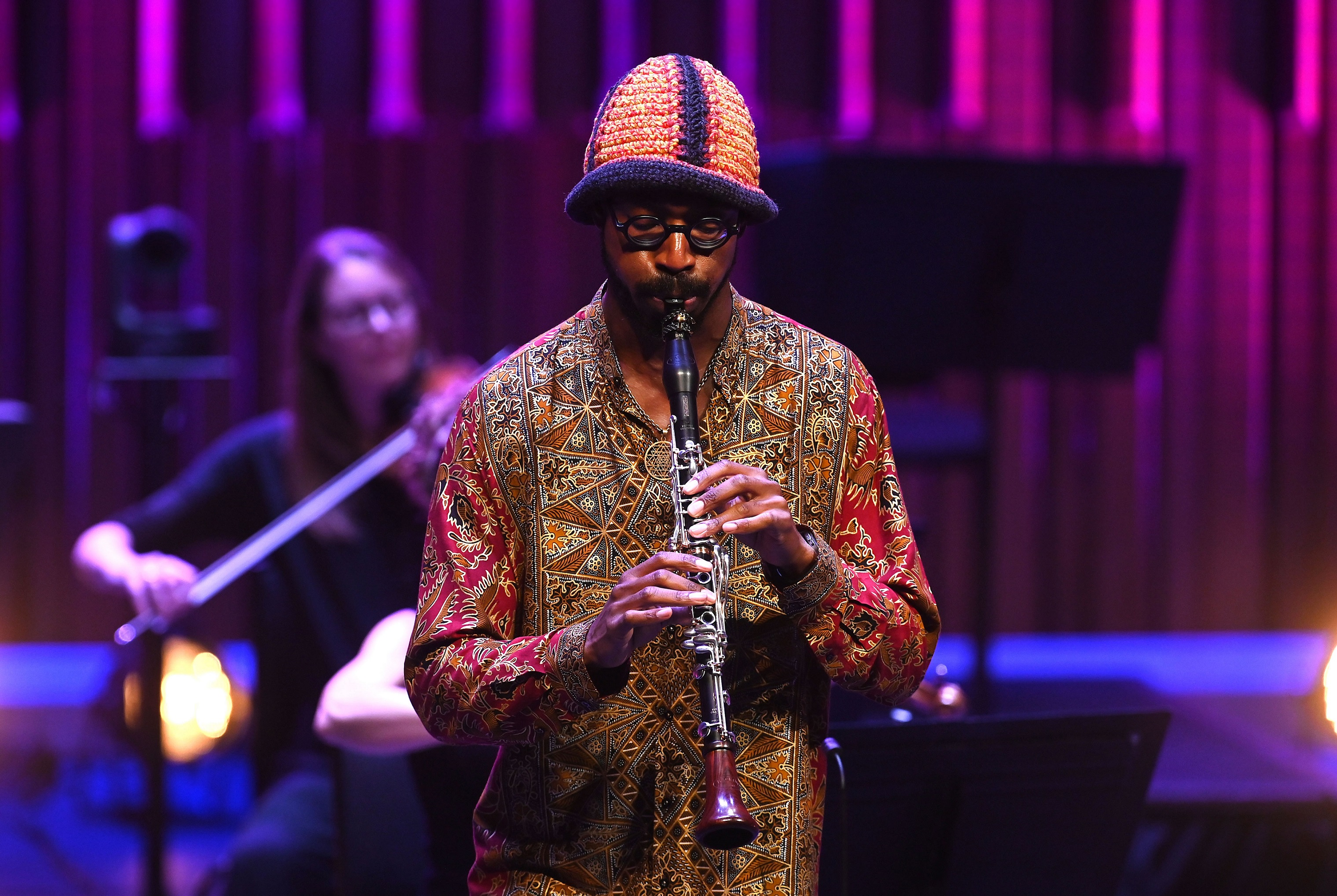Hutchings, Britten Sinfonia, Paterson, Barbican online review – saluting an American classic | reviews, news & interviews
Hutchings, Britten Sinfonia, Paterson, Barbican online review – saluting an American classic
Hutchings, Britten Sinfonia, Paterson, Barbican online review – saluting an American classic
Clarinet works by Copland and Stravinsky take centre stage at EFG London Jazz Festival
When Aaron Copland wrote his most beloved work, Appalachian Spring, in 1943/44, he gave it the unfussy working title of “Ballet for Martha” – Martha being the choreographer Martha Graham, for whom he’d written the score. It was only shortly before the premiere, long after the ink was dry on the score, that Graham appended the more alluring title, excerpted from Hart Crane’s poem "The Dance", by which the work is now known.
Scheduled as part of the Barbican’s Live from the Barbican series, as evidenced by last night’s performance by the Britten Sinfonia – in its original scoring for an ensemble of 13 instruments – what is incontrovertible is the communicative power of Copland’s music. Expertly conducted by Geoffrey Paterson, and brilliantly led by violinist Thomas Gould, the scintillating, edge-of-your-seat playing would surely convince even the most immovable naysayer that this was Copland’s finest score, vibrating as it does between a contemplative immobility and a compelling rhythmic drive (Britten Sinfonia pictured below).
One of the prime movers in the UK’s flourishing jazz scene, clarinettist, saxophonist and composer Shabaka Hutchings (Sons of Kemet, The Comet is Coming, Shabaka and the Ancestors) took to the Barbican stage to perform Igor Stravinsky’s Three Pieces for Solo Clarinet, composed in 1919. Hutchings shaped the first movement’s metrical asymmetry with great care, its liberal use of acciaccaturas and chromatic descending motif at times recalling the introduction of The Rite of Spring. Written entirely without bar lines or time signature, Hutchings made an impressive fist of the rapid-fire arpeggios and vertiginous registral leaps of the second movement, although the very opening phrase suggested that the notes weren’t entirely secure under his fingers. With its overt nods to the ‘Ragtime’ from The Soldier’s Tale, Hutchings handled the constant metrical shifts and breathlessness of the third movement with real conviction.
The six-minute clarinet improvisation which followed featured an extraordinary central section consisting of one unbroken melodic arc – with Hutchings, through the use of circular breathing, sustaining a single phrase for three minutes which at times created the impression of two-part counterpoint. The applause from the Britten Sinfonia players at its conclusion seemed entirely spontaneous (Shabaka Hutchings pictured below).
Cast in two movements connected by an extended cadenza, Hutchings and the Britten Sinfonia captured the 3/4 lilt of the opening movement, its absolute clarity of construction, and its profound melodicism to perfection, with the homogeneity of the string textures bathing the soloist in a warm glow.
Rather than recapitulating material heard in the first movement, the cadenza introduced themes which would be explored in the rhythmically charged second movement, the motoric rhythms of which sounded like the inner workings of some giant clock – with the addition of the exceptional pianist Catherine Edwards creating an even greater percussive bite. Despite some wobbly moments in the solo part during the faster passagework at the extremes of the clarinet’s register, the urgency of the pulse was undeniable, with the movement’s free rondo form referencing everything from Charleston rhythms to Brazilian folk song, all brought to a dramatic close by the soloist’s final glissando – a loving nod to Gershwin’s Rhapsody in Blue.
rating
Explore topics
Share this article
The future of Arts Journalism
You can stop theartsdesk.com closing!
We urgently need financing to survive. Our fundraising drive has thus far raised £49,000 but we need to reach £100,000 or we will be forced to close. Please contribute here: https://gofund.me/c3f6033d
And if you can forward this information to anyone who might assist, we’d be grateful.

Subscribe to theartsdesk.com
Thank you for continuing to read our work on theartsdesk.com. For unlimited access to every article in its entirety, including our archive of more than 15,000 pieces, we're asking for £5 per month or £40 per year. We feel it's a very good deal, and hope you do too.
To take a subscription now simply click here.
And if you're looking for that extra gift for a friend or family member, why not treat them to a theartsdesk.com gift subscription?
more Classical music
 Anja Mittermüller, Richard Fu, Wigmore Hall review - a glorious hall debut
The Austrian mezzo shines - at the age of 22
Anja Mittermüller, Richard Fu, Wigmore Hall review - a glorious hall debut
The Austrian mezzo shines - at the age of 22
 First Person: clarinettist Oliver Pashley on the new horizons of The Hermes Experiment's latest album
Compositions by members of this unusual quartet feature for the first time
First Person: clarinettist Oliver Pashley on the new horizons of The Hermes Experiment's latest album
Compositions by members of this unusual quartet feature for the first time
 Gesualdo Passione, Les Arts Florissants, Amala Dior Company, Barbican review - inspired collaboration excavates the music's humanity
At times it was like watching an anarchic religious procession
Gesualdo Passione, Les Arts Florissants, Amala Dior Company, Barbican review - inspired collaboration excavates the music's humanity
At times it was like watching an anarchic religious procession
 Classical CDs: Camels, concrete and cabaret
An influential American composer's 90th birthday box, plus British piano concertos and a father-and-son duo
Classical CDs: Camels, concrete and cabaret
An influential American composer's 90th birthday box, plus British piano concertos and a father-and-son duo
 Cockerham, Manchester Camerata, Sheen, Martin Harris Centre, Manchester review - re-enacting the dawn of modernism
Two UK premieres added to three miniatures from a seminal event of January 1914
Cockerham, Manchester Camerata, Sheen, Martin Harris Centre, Manchester review - re-enacting the dawn of modernism
Two UK premieres added to three miniatures from a seminal event of January 1914
 Kempf, Brno Philharmonic, Davies, Bridgewater Hall, Manchester review - European tradition meets American jazz
Bouncing Czechs enjoy their Gershwin and Brubeck alongside Janáček and Dvořák
Kempf, Brno Philharmonic, Davies, Bridgewater Hall, Manchester review - European tradition meets American jazz
Bouncing Czechs enjoy their Gershwin and Brubeck alongside Janáček and Dvořák
 Solomon, OAE, Butt, QEH review - daft Biblical whitewashing with great choruses
Even a top soprano and mezzo can’t make this Handel paean wholly convincing
Solomon, OAE, Butt, QEH review - daft Biblical whitewashing with great choruses
Even a top soprano and mezzo can’t make this Handel paean wholly convincing
 Two-Piano Gala, Kings Place review - shining constellations
London Piano Festival curators and illustrious friends entertain and enlighten
Two-Piano Gala, Kings Place review - shining constellations
London Piano Festival curators and illustrious friends entertain and enlighten
 Echo Vocal Ensemble, Latto, Union Chapel review - eclectic choral programme garlanded with dance
Beautiful singing at the heart of an imaginative and stylistically varied concert
Echo Vocal Ensemble, Latto, Union Chapel review - eclectic choral programme garlanded with dance
Beautiful singing at the heart of an imaginative and stylistically varied concert
 Scott, Irish Baroque Orchestra, Whelan, RIAM, Dublin review - towards a Mozart masterpiece
Characteristic joy and enlightenment from this team, but a valveless horn brings problems
Scott, Irish Baroque Orchestra, Whelan, RIAM, Dublin review - towards a Mozart masterpiece
Characteristic joy and enlightenment from this team, but a valveless horn brings problems
 Classical CDs: Voice flutes, flugelhorns and froth
Baroque sonatas, English orchestral music and an emotionally-charged vocal recital
Classical CDs: Voice flutes, flugelhorns and froth
Baroque sonatas, English orchestral music and an emotionally-charged vocal recital

Add comment